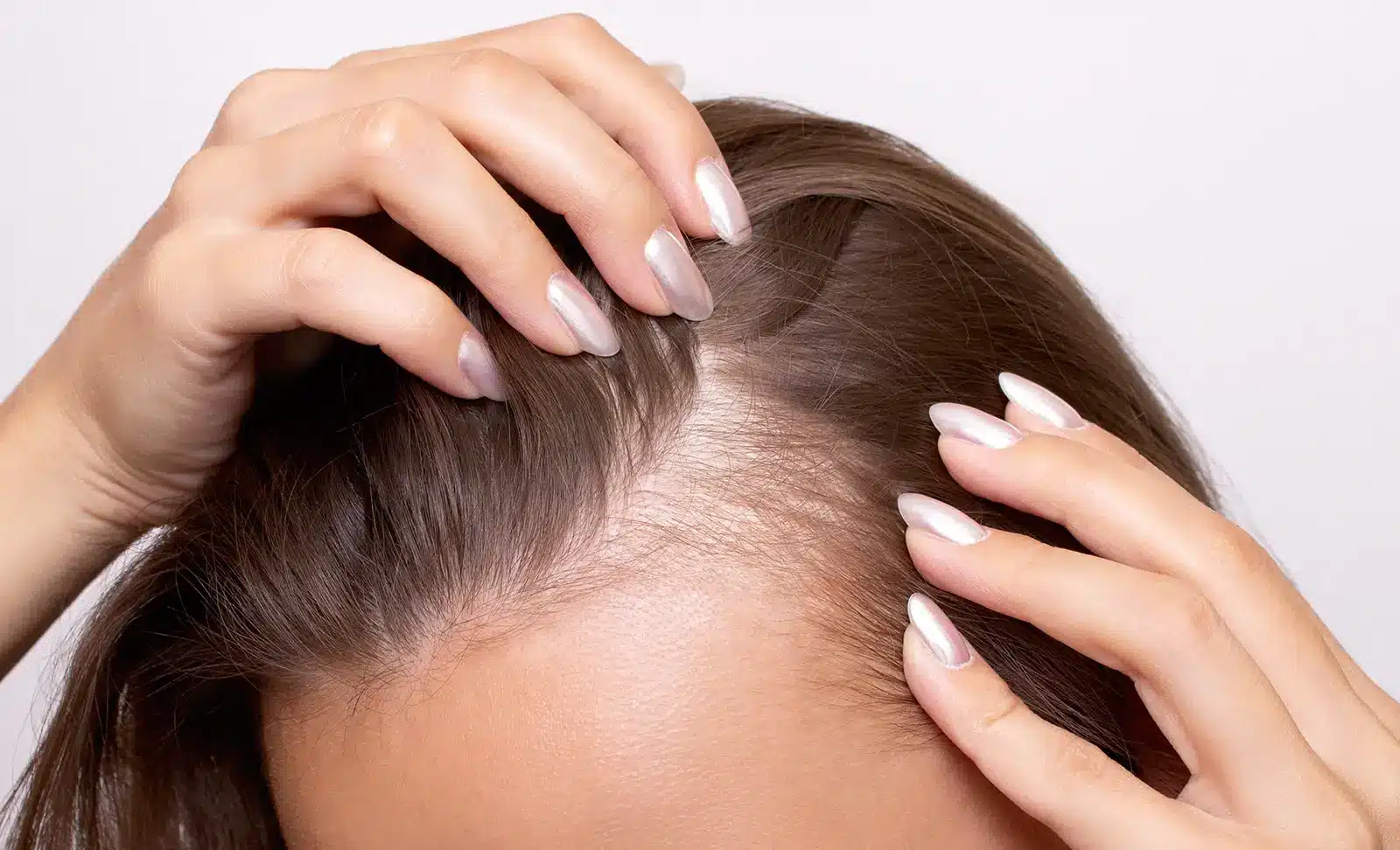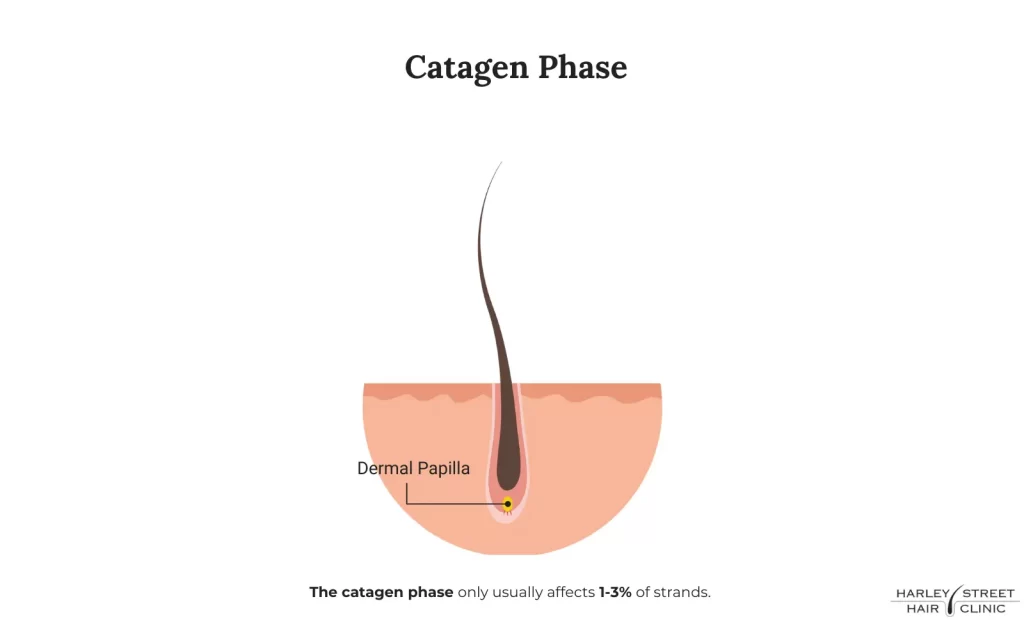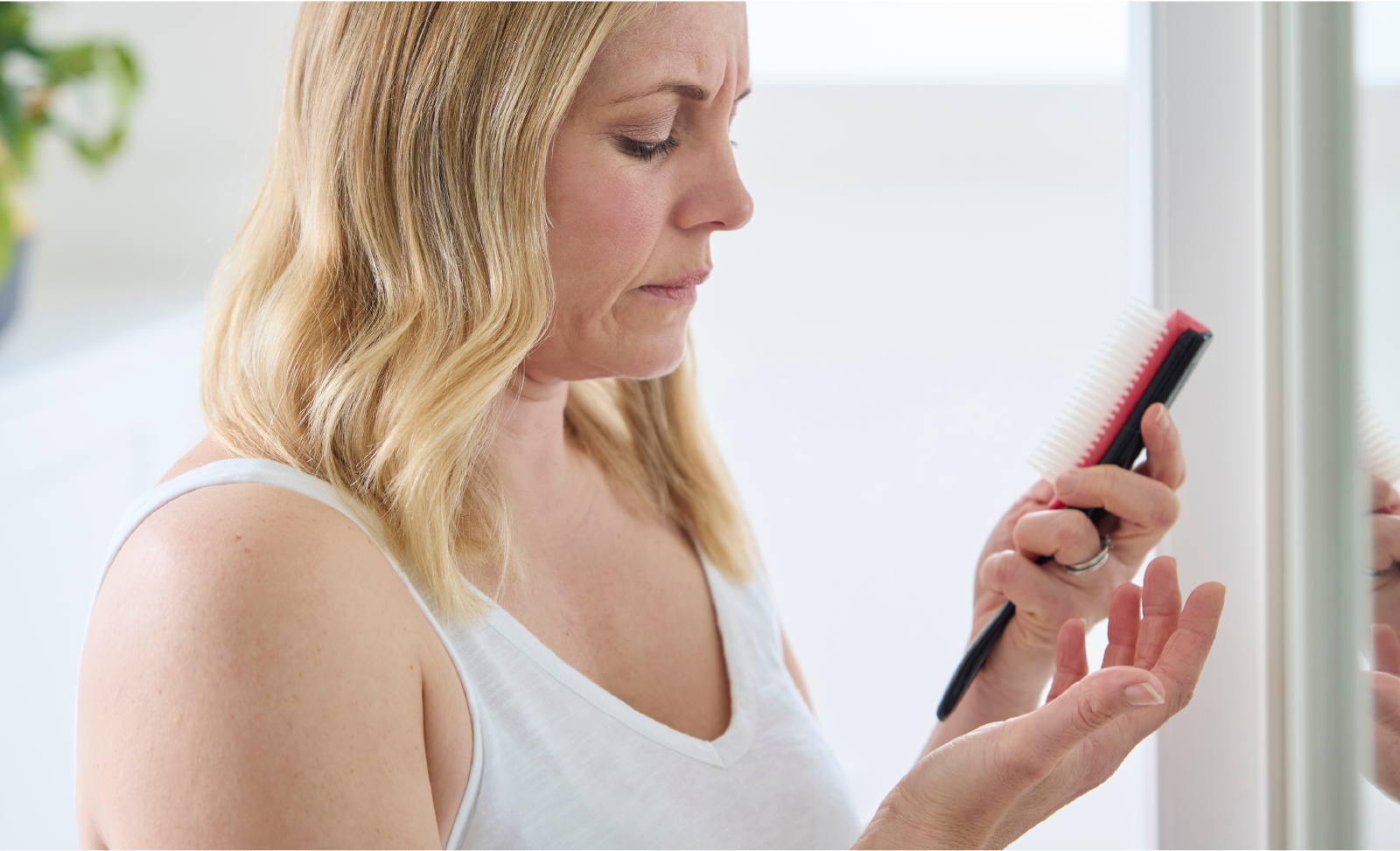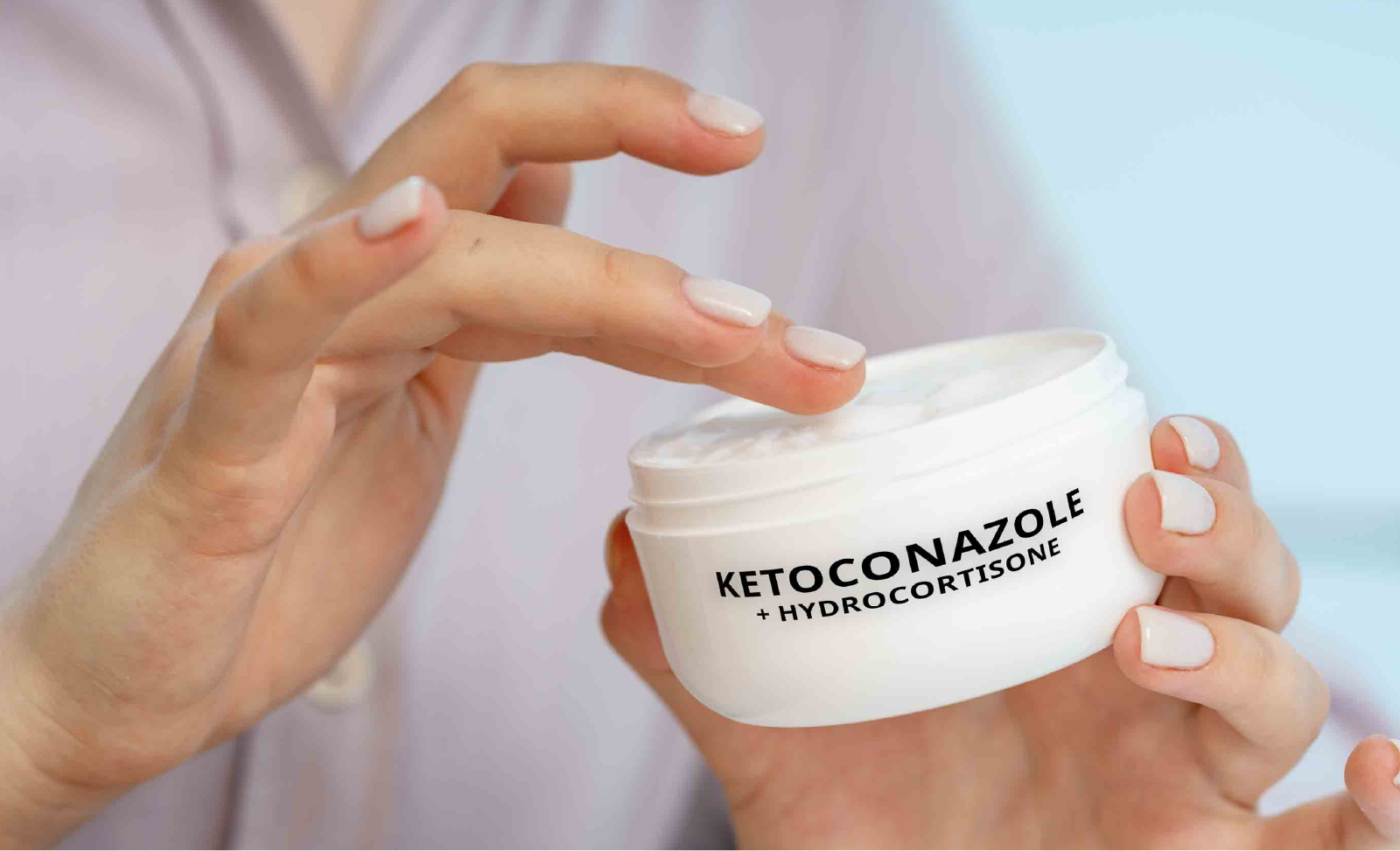Women experience ongoing hormonal changes throughout their lives. Unfortunately, this can sometimes lead to hair loss, especially if a condition like PCOS is involved. It’s important to get a blood test done at a GP to check hormone levels if you think something is off and causing side effects like hair loss.
- Can Hormones Cause Hair Loss? Yes, a hormonal imbalance can cause hair loss. For example, a woman with too much testosterone may experience thinning hair.
- Which Hormones Lead to Female Hair Loss? Some hormones that lead to female hair loss include testosterone, prolactin, cortisol, and insulin.
- What Are the Signs of Female Hair Loss? Women tend to experience thinning hair all over (compared to men, who tend to specifically experience hair loss on the temples and crown). You might notice a wider parting or a more visible scalp through your hair.
- How Do You Prevent Hormonal Hair Loss? Maintain a healthy lifestyle and manage your stress levels. If you notice any changes, speak to your doctor to get a blood test, as they will be able to test your hormone levels.
- What Conditions Cause Hormonal Changes? Several conditions cause hormonal changes in women, including PCOS, perimenopause, menopause, and pregnancy.
Hair loss is never easy to deal with, no matter your age. While hair loss and balding are often associated with men, many women also experience it, with female pattern hair loss affecting around 40% of all women by the time they reach 50. [1] It can cause serious self-esteem issues, leading to a lack of confidence.
One of the potential causes of female hair loss is hormonal changes. The question is, which hormones can cause this? Use this guide to learn more about female hair loss due to hormonal imbalances.
Understanding Female Hair Loss
To understand female hair loss, it first helps to get to grips with the hair growth cycle. There are four main stages of the cycle: [2]
Anagen Phase: This is when the hair grows. Normal, healthy hair will stay in the anagen phase for anywhere between two to eight years – the length of time depends on genetics. 85-90% of all your strands are in the anagen phase at a single time.
Catagen Phase: The catagen phase directly follows the anagen phase, which is when the hair follicles shrink, and hair growth quickly slows down. It is a short stage, only lasting a couple of weeks. The catagen phase only usually affects 1-3% of strands.
Telogen Phase: This is also known as the resting phase, as it is when the hairs stay on your head but do not grow. It’s estimated that around 9% of your hairs are in the telogen phase at any given time.
Exogen Phase: Finally, there’s the exogen phase, when your hair sheds. This is normal and causes between 50-100 hairs to fall out per day. As it’s all a cycle, this normal shedding won’t lead to overall hair loss.
Problems occur when there is a disruption to the hair growth cycle. If more hairs enter the catagen phase sooner, that can lead to hair loss and thinning hair. There are many potential causes of female hair loss, including a hormonal imbalance, which we’ll go into a little deeper further down.
The Signs of Female Hair Loss
Female pattern hair loss FPHL looks a little different from male pattern baldness. Here are the signs of hair loss in women:
Thinning Hair All Over
In women, hair loss typically looks like thinning hair all over. While men may experience balding at their temples and crowns, women are more likely to have their hair fall out from all over the scalp.
A Wide Parting
Female hair loss often produces a wider parting. If you used to have quite a tight-together parting, but now it’s over an inch, that’s a sign of hair loss.
Hair Falling Out
Hair falling out is a typical sign of female hair loss. It may come out in clumps while you brush, or you may notice more hair in your shower drain after washing.
Visible Scalp Skin
While it is normal to see some of your scalp at any given time due to your parting, extremely visible scalp skin is a sign of female hair loss. For example, there may be gaps when you tie up your hair.
If you have any of these signs of noticeable hair loss, speak to your doctor. You can also download our hair track app to get in touch with hair regeneration experts.
Hormones that Can Affect Female Hair Loss
Female hair loss due to hormonal imbalance is quite common – here are the most common hormonal culprits.
Testosterone
Testosterone is a hormone predominantly found in males. In men, it causes a receding hairline and a balding crown. If a woman has too much testosterone and other androgens, this can cause androgenetic alopecia or female pattern baldness.
Cortisol
Cortisol is a hormone that regulates the blood sugar. Too much of this stress hormone can cause hair loss in women as the stress disrupts the hair growth cycle, causing more hairs to go into the resting phase. Plus, too much stress can cause telogen effluvium, which causes rapid but reversible hair fallout.
Prolactin
Prolactin is a hormone that aids lactation and breast development, which means prolactin levels typically rise during and following pregnancy. [3] Too much of this hormone can cause an overproduction of DHT, which can lead to hair falling out.
Insulin
Another hormone that may cause female hair loss is insulin. It is a hormone that regulates blood sugar levels. If there is too much present in the body, it can disrupt the hair growth cycle, leading to excessive shedding.
What Conditions Cause Imbalanced Hormones?
There is no denying that female hair loss due to hormonal imbalance is quite common. So, what conditions are likely to cause it? Who is more at risk? Here are the most common hormonal causes of female hair loss.
Stress
Enduring too much stress for a lengthy period can elevate cortisol levels, which we established can lead to hair loss. Stress can cause telogen effluvium, a common condition that causes the hair to fall out quickly. The good news is this is usually reversible if stress levels are managed.
Medications
Certain medications can cause hormonal imbalances and lead to hair loss. Some of these include birth control pills, antidepressants, cancer drugs, steroids, and antipsychotics.
PCOS
PCOS, polycystic ovary syndrome, is a common condition that causes a hormonal imbalance in women. It affects the way the ovaries work, leading to symptoms like irregular periods, weight gain, excessive hair growth on the face, chest, and back, skin tags, and – yes – hair loss.
Pregnancy
Pregnancy often causes impactful hormonal changes. While some women may experience thicker, healthier hair during pregnancy due to the higher oestrogen levels, others may experience hair loss. It can also happen after giving birth.
Perimenopause
Perimenopause refers to a transitional period just before menopause when the body’s hormones can become imbalanced. It usually happens to women in their mid-40s, but it can occur earlier. Some of the symptoms include a loss of libido, hot flashes, mood instability, and sleep issues.
Menopause
Menopause is a process that typically occurs in a woman’s 50s when they stop having periods and can no longer get pregnant. It is an inevitable process and can start earlier in some cases. During this time, hormones change, with a decline in progesterone and oestrogen. Many of the symptoms overlap with perimenopause, including moodiness, hot flashes, trouble sleeping, and headaches.
Thyroid Conditions
Having a thyroid condition such as hyperthyroidism or hypothyroidism can affect the thyroid hormones in a woman’s body. Symptoms include irregular periods, weight loss or weight gain, dry skin, constipation, brittle hair, and depression.
How to Check Your Hormone Levels
If you think you’re experiencing female hair loss due to hormonal imbalance, you can get a blood test with your doctor. This blood test can check for a range of hormones, including reproductive hormones, adrenal hormones, and thyroid hormones. As a result, you can get a more accurate diagnosis and begin a treatment that works for you.
Female Hormonal Hair Loss Treatments
What about a good hair loss treatment? Experiencing hair loss due to hormonal changes does not mean you have to deal with thinning hair for the rest of your life; there are restoration options.
Minoxidil
Minoxidil is a hair loss medication often used to treat androgenetic alopecia in both men and women. It must be applied daily to keep on being effective, and it works by stimulating the blood flow to the scalp.
Platelet Rich Plasma Therapy
Platelet rich plasma therapy, commonly known as PRP, involves a set of injections using a person’s own blood. The growth factors in the blood contribute to stimulated hair follicles, leading to hair growth.
Low-Level Laser Therapy
Low-level laser therapy is a hair stimulation procedure that uses low-level lasers, as the name suggests. It works by stimulating the hair follicles, triggering them into activation that leads to hair growth.
Hair Transplant
A hair transplant is good for the type of hair loss caused by genetics and hormones, specifically female pattern baldness. The surgery is minimally invasive, extracting individual follicles and transplanting them into the thinning section. After the procedure, you will notice your hair grows where it previously didn’t, leading to a full head of hair once more.
A hair transplant is an excellent idea if other solutions do not work. It’s for those with pretty severe hair loss who want a permanent solution.
Hair Loss Hormones Female: Summary
As you can see, female hair loss due to hormonal imbalances is quite common. Pregnancy, menopause, perimenopause, PCOS, and thyroid conditions can all disrupt your balanced hormones and cause your hair to fall out. It’s important to speak with your doctor if you’re worried about it or are showing any symptoms.
Are you ready to tackle female hair loss once and for all? We are hair restoration experts here at Harley Street Hair Clinic, so let us help you. Contact our friendly team or head to our patients gallery to learn more about what we do.
Sources:
- https://pmc.ncbi.nlm.nih.gov/articles/PMC4573453/
- https://www.healthline.com/health/stages-of-hair-growth#growing-phase
- https://my.clevelandclinic.org/health/articles/22429-prolactin#:~:text=Prolactin%20levels%20normally%20rise%20during,stress%2C%20such%20as%20experiencing%20pain.






